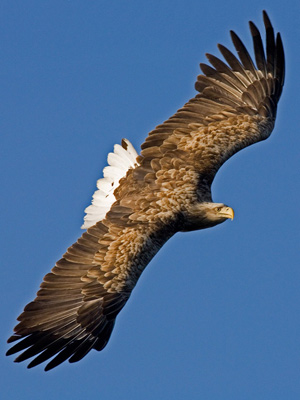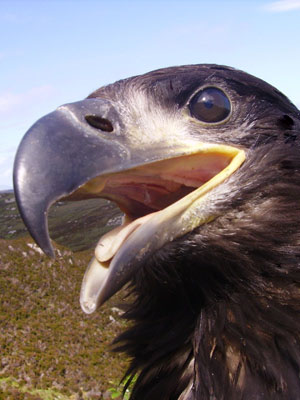
Scottish Raptor Study Group
Monitoring and conserving Scotland's birds of prey
White-Tailed Eagle

The steady decline of the white-tailed eagle population in the British Isles resulted in its final extinction in 1918. Following two failed earlier attempts, the species was re-introduced into Scotland between 1975 and 1985 using donor stock from Norway. On release these captive reared birds roamed widely before settling on the west coast of Scotland and starting to breed from the early 1980s. The first eggs were laid on Mull in 1983, but failed to hatch. Two years later however, the first wild Scottish white-tailed eagle chick for more than seventy years fledged. Since then, the population has slowly expanded, bolstered by another west coast re-introduction phase between 1993 and 1998. Along the way territories have been occupied and then abandoned, breeding trios have occasionally been formed, clutches of eggs have been stolen by collectors and sadly some birds have been illegally poisoned or shot. Nevertheless, due to the monitoring, protection and careful management by an army of workers, both professional and voluntary, in the office and in the field, the population has gradually gained an increasingly firm foothold. Management has included continuous protection of nest sites throughout incubation, supplementary feeding, and even the placement of orphaned young into foster nests as opposed to captive rearing, to maximise opportunity of survival in the wild.
So from 1985 onwards white-tailed eagles have bred successfully in the wild in Scotland, although after the first ten years the population appeared to have reached a plateau of only a dozen territories, with very marked differences between the least and the most productive. However, a milestone was passed in 1995 when the first territory was occupied by a Scottish-bred bird. Then from 1998 birds from the second re-introduction phase also started to enter the breeding population and from then on the population has shown a healthier increase. In 2000 another significant milestone was reached when the 100th wild chick fledged in the re-established population, and by 2012 the number of territories exceeded 65.

Throughout this period data have been collected in order to study movements of birds and longevity. This has involved a careful programme of marking young birds in order to be able to identify them individually from a distance. Originally birds were colour-ringed, but from 1987 these were replaced by coloured wing tags which were easier for members of the public to notice, identify and, hopefully, report. However, the eagles had a tendency to lose these over time and so from 2008 colour rings have again been used. These are anodized riveted leg rings and are part of the European colour ringing programme co-ordinated by Swedish white-tailed eagle research scientists. In addition to this, ongoing dietary studies are showing the wide range of prey species hunted, scavenged and pirated by Scottish white-tailed eagles in their primarily coastal habitat.
At the moment the Scottish west coast is still probably the best place to see white-tailed eagles in their natural environment in the British Isles - with Skye and Mull being particularly recommended. Nomadic immatures are, of course, recorded occasionally all over the country. However, in 2007 a third phase of the white-tailed eagle re-introduction project commenced, aimed at re-establishing the species to the richer lochs, firths and wetlands of the lowland Scottish east coast. Between 2007 and 2012, 85 well feathered nestlings were brought in, once again from Norway, reared in captivity and released into the wild. These birds were wing-tagged (with the exception of the 2008 cohort which were colour-ringed) and also fitted with 5 year VHF radios to help project staff track their whereabouts. They too have been ranging far and wide up and down the east coast and occasionally over to the west. And while pair bonding and territory formation has been happening in the east, in fact the first successful breeding attempt of an east coast white-tailed eagle took place on Mull, with a 2007 female paired up with a 2007 male from Mull.
Justin Grant
References:
Bainbridge, I.P., Evans, R.J., Broad, R.A., Crooke, C.H., Duffy, K., Green, R.E., Love, J.A. and Mudge, G.P. (2003). Reintroduction of white-tailed eagles (Haliaeetus albicilla) to Scotland. In Thompson, D.B.A., Redpath, S.M., Fielding, A.H., Marquiss, M. and Galbraith, C.A. (Eds.). Birds of Prey in a Changing Environment. The Stationary Office, Edinburgh. Pp. 393-406.
Evans, R.J., Pearce-Higgins, J., Whitfield, D.P., Grant, J.R., MacLennan, A. and Reid, R. (2010). Comparative nest habitat characteristics of sympatric White-tailed Haliaeetus albicilla and Golden eagles Aquila chrysaetos in western Scotland. Bird Study 57: 473-482.
Evans, R.J., Wilson, J.D., Amar, A., Douse, A., MacLennan, A., Ratcliffe, N. and Whitfield, D.P. (2009). Growth and demography of a re-introduced population of white-tailed eagles Haliaeetus albicilla. Ibis 151: 244-254.
Grant, J.R. (2010). White-tailed sea eagle, Scotland. In Tingay, R.E. and Katzner, T.E. (Eds.). The Eagle Watchers: Observing and Conserving Raptors around the World. Cornell University Press, New York. Pp. 188-194.
Grant, J.R., Reid, R. and Whitfield, D.P. (2011). Clearing nests of food remains does not influence subsequent nest choice in white-tailed eagles. Scottish Birds 31: 308-310.
Green, R.E., Pienkowski, M.W. and Love, J.A. (1996). Long-term viability of the re-introduced population of the white-tailed eagle Haliaeetus albicilla in Scotland. Journal of Applied Ecology 33: 357-368.
Love, J.A. (1983). The Return of the Sea Eagle. Cambridge University Press, UK.
Love, J.A. (2003). A history of the white-tailed sea eagle in Scotland. In Helander, B., Marquiss, M. and Bowerman, W. (Eds.). Sea Eagle 2000: Proceedings from an International Conference at Björkö, Sweden, 13-17 September 2000. Swedish Society for Nature Conservation, Stockholm. Pp. 39-50.
Love, J.A. (2006). Sea Eagles. Scottish Natural Heritage, Perth.
Love, J.A. (2010). White-tailed sea eagle, Scotland. In Tingay, R.E. and Katzner, T.E. (Eds.). The Eagle Watchers: Observing and Conserving Raptors around the World. Cornell University Press, New York. Pp. 201-206.
Love, J.A. (2013). A Saga of Sea Eagles. Whittles Publishing, Caithness.
Marquiss, M., Madders, M. and Carrs, D.N. (2003). White-tailed eagles (Haliaeetus albicilla) and lambs (Ovis aries). In Thompson, D.B.A., Redpath, S.M., Fielding, A.H., Marquiss, M. and Galbraith, C.A. (Eds.). Birds of Prey in a Changing Environment. The Stationery Office, Edinburgh. Pp. 471-479.
Whitfield, D.P., Duffy, K., McLeod, D.R.A., Evans, R.J., MacLennan, A.M., Reid, R., Sexton, D., Wilson, J.D. and Douse, A. (2009). Juvenile dispersal of white-tailed eagles in western Scotland. Journal of Raptor Research 43: 110-120.
Whitfield, D.P., Douse, A., Evans, R.J., Grant, J., Love, J., McLeod, D.R.A., Reid, R. and Wilson, J.D. (2009). Natal breeding dispersal in a reintroduced population of white-tailed eagles Haliaeetus albicilla. Bird Study 56: 177-186.
Whitfield, D.P., Evans, R.J., Broad, R.A., Fielding, A.H., Haworth, P.F. and McLeod, D.R.A. (2002). Are re-introduced white-tailed eagles in competition with golden eagles? Scottish Birds 23: 36-45.
Whitfield, D.P., Marquiss, M., Reid, R., Grant, J., Tingay, R.E. and Evans, R.J. (2013). Breeding season diets of sympatric white-tailed eagles and golden eagles in Scotland: no evidence for competitive effects. Bird Study 60: 67-76.
Scottish Raptors•
Honey-Buzzard•
Red Kite•
White-Tailed Eagle•
Marsh Harrier
Hen Harrier•
Goshawk•
Sparrowhawk•
Common Buzzard•
Golden Eagle
Osprey•
Kestrel•
Merlin•
Hobby•
Peregrine Falcon•
Barn Owl
Tawny Owl•
Long-eared Owl•
Short-eared Owl•
Raven